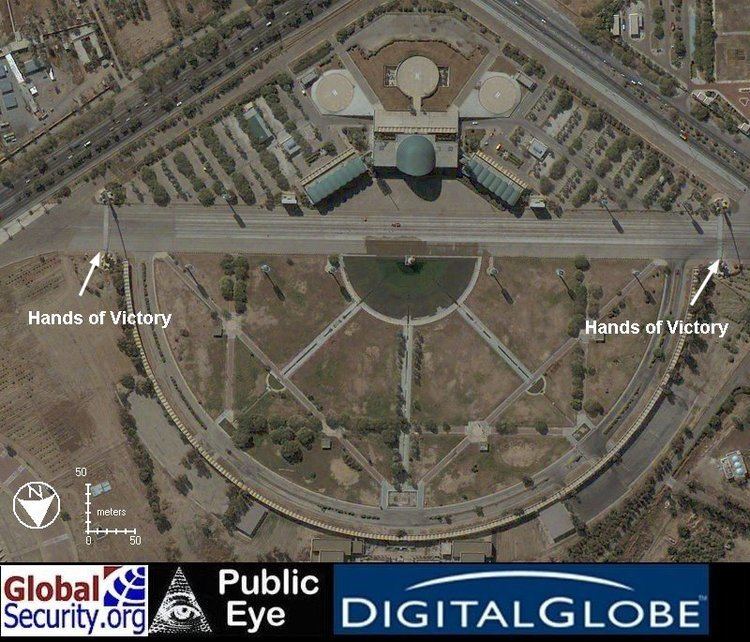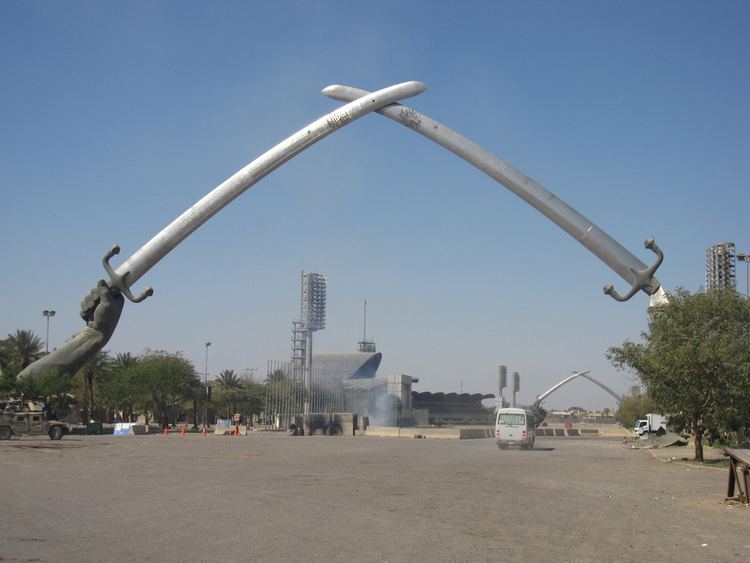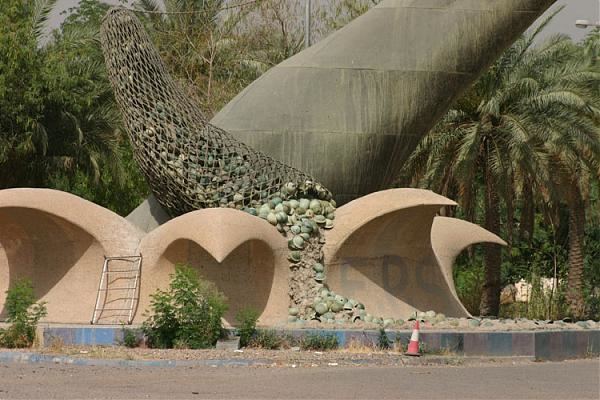Similar Grand Festivities Square, The Monument to the Un, Al‑Shaheed Monument, Al‑Faw Palace, National Museum of Iraq | ||
Me at the victory arch baghdad iraq
The Arc of Triumph (Arabic: قوس النصر Qaws an-Naṣr), also called the Swords of Qādisīyah، and Hands of Victory in some Western sources, are a pair of triumphal arches in central Baghdad, Iraq. Each arch consists of a pair of hands holding crossed swords. The two arches mark the two entrances to Great Celebrations square and the parade ground constructed to commemorate the Iran-Iraq war, led by then Iraqi President Saddam Hussein. The arches were opened to the public on August 8, 1989. It is one of Baghdad's sights and monuments and near to The Monument to the Unknown Soldier.
Contents
Location

In 1986 (two years before the war's end) the government of Iraq began the construction of a festival and parade ground in Zawra Park, near the extensive presidential complex in the center of Baghdad. Known as Grand Festivities Square, it comprised a large parade ground, an extensive review pavilion, and the two arches. The official name of the arches, the Swords of Qādisiyyah, is an allusion to the historical Battle of al-Qādisiyyah.

The site was home to the Museum of Gifts to the President and a performing arts center. The museum was located on the ground floor of the grand reviewing pavilion where Saddam was known to review the Republican Guard while firing a weapon in the air. The museum contained ordinary items donated by Iraqis during his rule. Items included cheap plastic ornaments and drawings donated by Iraqi children.

The Grand Festivities Square also contained a large reflecting pool. The surrounding grassy areas hosted Iraqis during military parades. Adding to the festive appeal of the grounds were three refreshments booths that sold ice cream, cold beverages, and candy.
History
Iraq's leading sculptor, Adil Kamil, won the commission to design and execute the construction of the arches, which were based on a concept sketch made by president Saddam Hussein. The design consists of a pair of massive hands emerging from the ground, each holding a 43-metre-long (141 ft) sword. A small flagpole rises from the point where the swords meet, at a point about 40 metres (130 ft) above the ground. Kamil used photographs and plaster casts of Saddam's forearms to model for the design of the hands. When Kamil died in 1987, with the monument incomplete, his position was assumed by fellow artist Mohammed Ghani Hikmat. Ghani personally took an impression of one of Saddam's thumbs, and the resulting fingerprint was added to the mold for one of the arches' thumbs.

The arches were made by an international consortium led by the German foundry H+H Metallform. The blades of the stainless steel swords weigh 22 tonnes (24 short tons) each. Cast in Iraq, they are partly composed of metal from guns and tanks of Iraqi soldiers killed in the Iran-Iraq war. The hands and arms of the monument are cast in bronze, cast in the United Kingdom at the Morris Singer Foundry. The arms rest on concrete plinths, the form of which make the arms appear to burst up out of the ground. Each plinth holds 2,500 helmets which, Saddam claimed, belonged to Iranian soldiers killed during the war; they are held in nets which spill them onto the ground beneath.

On the day the monument was dedicated in 1990, Saddam rode under the arches astride a white horse. It has been suggested that this was an allusion to the slain Shiite martyr Hussein, killed in Karbala in AD 680, whose death caused the rift between Shiite and Sunni Muslims.

Samir al-Kalil's book Monument: Art, Vulgarity, and Responsibility in Iraq describes the Arc of Triumph and Saddam's programme of producing lavish monuments celebrating his reign.
The monument was not destroyed during the 1991 Persian Gulf War, though General Norman Schwarzkopf wanted to. The arches remain standing in what is now the International Zone of Baghdad. The hands are hollow, and many troops and other coalition visitors have climbed up inside them to look out from the point at which the swords meet the hands, generally to have souvenir pictures taken.
Demolition attempt
In February 2007, it was reported that the new Iraqi government had organized the Committee for Removing Symbols of the Saddam Era and that the Arc of Triumph monument had begun to be dismantled, which drew protests from Iraqi and preservationist groups.

The demolition began on Tuesday, February 20, 2007. At that time, 3-metre (10 ft) chunks had been cut out of the bronze monument. Numerous Iraqi bystanders and coalition troops were seen taking helmets and bits of the monument away as souvenirs. The decision to remove the monument, made by Prime Minister Nouri al-Maliki, was challenged by U.S. Ambassador Zalmay Khalilzad, who blocked the demolition on February 21.
The government of Iraq reversed its earlier plans to demolish the monument.
In February 2011, Iraqi authorities began the restoration of the monument as a sign of reconciliation.
